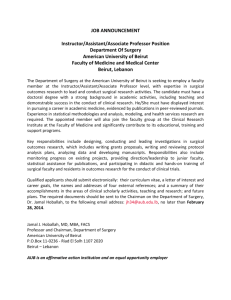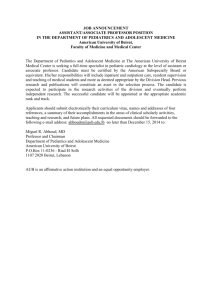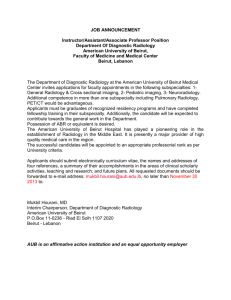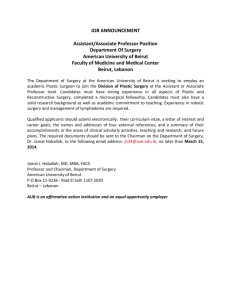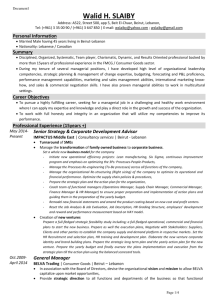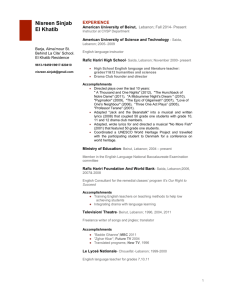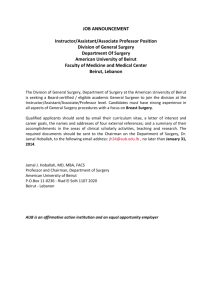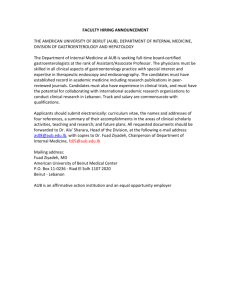Project Name - Documents & Reports
advertisement
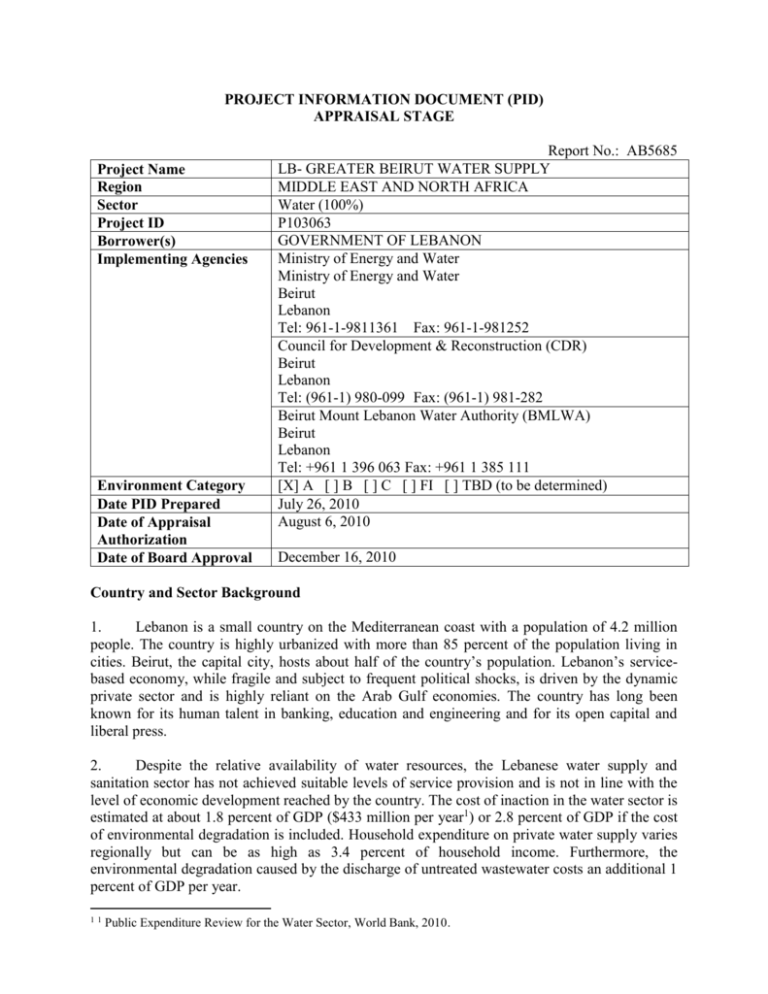
PROJECT INFORMATION DOCUMENT (PID) APPRAISAL STAGE Project Name Region Sector Project ID Borrower(s) Implementing Agencies Environment Category Date PID Prepared Date of Appraisal Authorization Date of Board Approval Report No.: AB5685 LB- GREATER BEIRUT WATER SUPPLY MIDDLE EAST AND NORTH AFRICA Water (100%) P103063 GOVERNMENT OF LEBANON Ministry of Energy and Water Ministry of Energy and Water Beirut Lebanon Tel: 961-1-9811361 Fax: 961-1-981252 Council for Development & Reconstruction (CDR) Beirut Lebanon Tel: (961-1) 980-099 Fax: (961-1) 981-282 Beirut Mount Lebanon Water Authority (BMLWA) Beirut Lebanon Tel: +961 1 396 063 Fax: +961 1 385 111 [X] A [ ] B [ ] C [ ] FI [ ] TBD (to be determined) July 26, 2010 August 6, 2010 December 16, 2010 Country and Sector Background 1. Lebanon is a small country on the Mediterranean coast with a population of 4.2 million people. The country is highly urbanized with more than 85 percent of the population living in cities. Beirut, the capital city, hosts about half of the country’s population. Lebanon’s servicebased economy, while fragile and subject to frequent political shocks, is driven by the dynamic private sector and is highly reliant on the Arab Gulf economies. The country has long been known for its human talent in banking, education and engineering and for its open capital and liberal press. 2. Despite the relative availability of water resources, the Lebanese water supply and sanitation sector has not achieved suitable levels of service provision and is not in line with the level of economic development reached by the country. The cost of inaction in the water sector is estimated at about 1.8 percent of GDP ($433 million per year1) or 2.8 percent of GDP if the cost of environmental degradation is included. Household expenditure on private water supply varies regionally but can be as high as 3.4 percent of household income. Furthermore, the environmental degradation caused by the discharge of untreated wastewater costs an additional 1 percent of GDP per year. 11 Public Expenditure Review for the Water Sector, World Bank, 2010. 3. The Greater Beirut and Mount Lebanon area houses about 40% of the total Lebanese population. Despite relatively high municipal connection rates reaching 90%, the continuity of water supply is low and reaches as little as 3 hours per day in the lean summer season. This seasonal water imbalance is primarily caused by very low water storage capacity, high amount of water lost to the sea, growing demand for water and the deficiency of existing water networks. Average technical and commercial losses are as high as 40% and further aggravate supply intermittency. In this context, small scale private water vendors have provided water of dubious quality. If no actions are taken to improve distribution efficiency and increase storage capacity, it is estimated that the seasonal imbalance of water resources will lead to chronic water shortages by as early as 2020. 4. Beirut Mount Lebanon Water Authority (BMLWA) is the Regional Water Authority responsible for the Greater Beirut and Mount Lebanon area comprising the towns of Jbeil, Barouk, Metn, Ein el Delbi and Keserwan with approximately 2.2 million registered users equivalent to approximately 350,000 registered households. BMLWA also services the lowincome neighborhoods in Southern Beirut where approximately 200,000 people reside. 5. BMLWA is a public institution established in 2000 through Law 221(2000) which amalgamated numerous “water establishments”, including the “Beirut Water Establishment” and “Ein El Delbi Water Establishment” into a unified “Beirut Mount Lebanon Regional Water Authority”. BMLWA operates as a commercial entity, is headed by a General Director who also chairs the Board, and oversees an organization of approximately 2000 part-time and full-time staff. Due to a longstanding hiring freeze within the Government however, many of these positions remain vacant and BMLWA is thus considerably understaffed, with many existing staff nearing retirement. 6. BMLWA delivers water to a “gauge” flow-device installed in every apartment building, the most common form of residence across urban Lebanon. The gauge is designed to allow a flow of 1 m3/day for every apartment of area equivalent to 200 m2 or less. Larger apartments are allocated larger volumes of water per day and subsequently pay a higher gauge tariff. Only 16% of registered users are metered, with 11% of these representing large industrial and commercial users of significantly higher consumption rates. Since water rationing is frequent and reaches as low as 3 hours per day in the summer, most residences have installed communal pumps and individual roof-top reservoirs to store water when it is delivered. 7. The gauge water tariff is LLB 236,000 (US$157) per year per household for 1 m3/day for each 200 m2 of household area, and LLB 324,000 (US$216) per household for limited metered connections. The metered connections have more regular water services, and have a price adjustment at the end of the year reflecting the volume of consumed water. On average, BMLWA collection rate has been consistent at 90 percent per year. Thus, the combination of: (a) a relatively high yearly gauge tariff (equivalent to approximately 4% of minimum wage income) due in full yearly (b) the water shortages across the Greater Beirut Mount Lebanon area, and (c) the relatively satisfactory collection rate, given the low quality of service – have all resulted in BMLWA amassing over US$ 170 million in reserves. 8. BMLWA’s strong financial position has thus enabled it to contribute US$ 140 million of equity sharing on the Greater Beirut Water Supply Project - equivalent to 36 percent of the total project cost. Institutional Players The Ministry of Energy and Water (MoEW): is the main agency with oversight and regulatory power in the water sector, including water resource management. The MoEW is in charge of budget-financed investments and exercises technical oversight over the four Regional Water Authorities and is responsible for setting water standards, pollution control and enforcing legislation. The Council of Development of Reconstruction (CDR): is a financially autonomous public institution attached to the office of the President of the Council of Ministers and is in charge of planning and executing donor-funded investments, including for the water and wastewater sectors. It was created in 1977 to coordinate the re-construction effort and to implement the associated investment programs in collaboration with line ministries. Regional Water Authorities (RWA) Municipal water across Lebanon is provided by four consolidated RWAs and one pre-existing river basin agency (the Litani River Authority). The four RWAs are responsible for (a) the study, execution, operation and maintenance and renovation of potable water supply, irrigation and wastewater according to the General Master Plan and as per the instructions of the MoEW; (b) setting water tariffs for potable water supply and irrigation taking into account socio-economic conditions; and (c) quality control of potable water and water for irrigation. Rationale for Bank involvement 9. The Bank has been actively engaged in Lebanon’s water sector since 1993. An Emergency Reconstruction and Rehabilitation Project (ERRP) of US$275 million, of which approximately US$90 million was for the water sector, was implemented between 1993 and 2002. In addition, the ongoing Ba’albeck Water and Wastewater project (US$43.5 million in 2002), the Irrigation Rehabilitation and Modernization project (US$70), the West Beka’a Emergency Water Supply Project (US$15 million Grant in 2007), Irrigation policy note (2004) and the recently completed Water Sector Public Expenditure Review in 2009 are examples of the Bank’s continuous engagement in policy advice and investment lending in Lebanon. 10. The proposed Greater Beirut Water Supply Project has been under consideration by the Lebanese Government since the early 1960s and has constantly featured in the Government’s infrastructure development plans. In the late 90s, the Bank provided technical assistance to the Government for the implementation of the Greater Beirut Water Project on a Build-OperateTransfer (BOT) basis. This plan was later cancelled at the Government’s request but the Bank teams retain a strong understanding of the project and its objective to alleviate the critical water shortage currently impeding effective development within the Greater Beirut Region. Project Description 11. The project development objective is to increase access to potable water in the Greater Beirut Region, including the low-income neighborhoods of Southern Beirut, and to strengthen the capacity of BMLWA in utility operation. 12. Achievement of the development objective will be assessed through the following key performance and core indicators: Number of people in low-income neighborhoods of Southern Beirut provided with access to improved water sources under the project. Volume (m3) of additional potable water distributed in project area. Increase in water supply hours to customers served under the project. Number of water utilities supported by the project. 13. The proposed Greater Beirut Water Supply Project aims to build, operate and maintain the intake, treatment, conveyance and storage infrastructure required to meet the immediate and pressing demand for 250,000 m3/d of potable water in the Greater Beirut and Mount Lebanon – by building a conveyor, water treatment plant, storage reservoirs and distribution networks to deliver Litani and Awali River water to the Greater Beirut Region. It will consist of the following three components: 14. Component 1: Bulk Water Supply Infrastructure: Tunnels, Water Treatment Plant, Transmission & Bulk Storage Component 1 will comprise: (a) the construction of two water tunnel conveyors; (b) a water treatment plant; (c) two transmission pipelines km; (d) three storage reservoirs of 35 ML, 50 ML and 20 ML capacity respectively; and (e) all related equipment including pumps and valves. 15. Component 2: Supply Reservoirs, Distribution Network and Metering Component 2 will comprise: (a) the construction of 16 supply reservoirs, dispersed within the project area; (b) the replacement and/or installation of water supply network of about 187 Km of pipelines as well as local reservoirs and pumping stations; (c) the installation of 200,000 meters in specific pilot project areas, and (d) the installation of about 100 bulk water meters. 16. Component 3: Project Management, Utility Strengthening and Studies Component 3 will build the capacity of BMLWA staff on: (a) international accounting, procurement and financial management standards; (b) water treatment plant operation; (c) water meter installation and operation; (d) commercial billing, marketing and public outreach; and (e) other capacity building activities geared at institutional strengthening within BMLWA and other RWAs. Component 3 will also finance select high priority studies, of national relevance on specific sector issues, including water resource management, wastewater management, interbasin transfers and water supply augmentation schemes. Financing 17. The lending instrument will be a Specific Investment Loan that will be aimed at supporting the creation, rehabilitation, and maintenance of water supply infrastructure in the Greater Beirut area. 18. Total project financing requirements are estimated at US$ 370 million, inclusive of price and physical contingencies, taxes and the front-end fee. The project will be jointly financed as follows: BMLWA will finance US$140 million and the GOL will finance US$30 million for land acquisition and the front-end fee. The remaining costs of US$200 million for goods, works, consultants, reasonable associated taxes and contingencies will be funded by the IBRD loan. Detailed information on costs and financing sources is provided in Table 1. Table 1. Project Costs by Component and Use of Financing Total Project Cost By Component and/or US$ Activity million A. Works, Goods and Consultants Component 1: Bulk Water Supply A. Raw and treated water tunnels 130 Works and supervision B. Water treatment plant 51 Works and supervision C. Transmission pipelines, reservoirs 55 Works and supervision Component 2: Distribution, and Metering A. Distribution and reservoirs 41 Works and supervision 20 B. Metering Component 3: Project 15 Management, Utility Strengthening and Studies Subtotal 312 28 B. Land Acquisition Total Baseline Cost 342 20 C. Contingencies 6 D. Taxes Total Project Costs 368 Front-End Fee 2 Total Financing Required 370 Institutional and implementation arrangements 19. The MoEW will be the administrative Ministry with responsibility for the project. It will have a Project Steering Committee headed by H.E. the Minister, with representatives from key stakeholders including the Ministry of Finance, CDR and BMLWA. CDR will be responsible for the implementation of Component 1 of the project, while BMLWA will be responsible for implementation of Components 2 and 3. Sustainability 20. Sustainability of the proposed project will ultimately be determined by the sustainability of the water sector as a whole, and at the project level, by the proper implementation and operation of the proposed project. Specifically, the sustainability of the project will largely depend on: (a) the professionalization of BMLWA and its staff by successful implementation of international corporatization procedures including accounting and billing standards, non-revenue water reduction and targeted staff training to operate and maintain the new infrastructure; and (b) the adoption of full metering on a volumetric basis across BMLWA project area, thereby controlling water consumption and operation and maintenance costs. Lessons Learned from Past Operations in the Country/Sector 21. The following aspects of the project have been built into the design as a result of lessons learned from current water and sanitation projects and the analytical work undertaken in Lebanon) and elsewhere: An independent and autonomous utility run under sound commercial principles and with professional staff provides the most efficient water supply and sewerage services. The water utility needs to play a leading role in the implementation and operation of a water supply project and operate within an appropriate regulatory framework and with clear policies and procedures. Government should play the role of facilitator and provide the enabling environment for effective service delivery. There should be effective coordination and cooperation between the relevant agencies/ministries involved in the sector. The consumer’s voice should be heard while planning and implementing the project Safeguard Policies Safeguard Policies Triggered by the Project Environmental Assessment (OP/BP 4.01) Natural Habitats (OP/BP 4.04) Pest Management (OP 4.09) Indigenous Peoples (OP/BP 4.10) Physical Cultural Resources (OP/BP 4.11) Involuntary Resettlement (OP/BP 4.12) Forests (OP/BP 4.36) Safety of Dams (OP/BP 4.37) Projects on International Waterways (OP/BP 7.50) Projects in Disputed Areas (OP/BP 7.60)* Yes [X] [] [] [] [] [X] [] [] [] [] No [] [X] [X] [X] [X] [] [X] [X] [X] [X] List of Factual Technical Documents 22. The list of factual technical documents supporting the proposed project include: Feasibility Study Update: 2010; Feasibility Study and Preliminary Design: Study and Design for Greater Beirut Water Supply and Wastewater Development, 2000, ACE; Update of Water Supply Masterplan for Greater Beirut, 1997, Gibb- KA KCIC; Update of Water Supply Masterplan – Infrastructure, 1997, Gibb- KA KCIC; Update of Water Supply Masterplan - Study of Unaccounted for Water, 1997, Gibb- KA KCIC; Awali-Beirut Water Supply Feasibility Report, 1994, Montgomery Watson & Engico; Awali-Beirut Water Supply Ground Investigation Report and Annexes, 1995, INSITU; and Awali-Beirut Water Conveyor (BOT) – EIA, 2000, Montgomery Watson & Engico, European Capital, Hannah & Mould. Contact point Mr. Parameswaran Iyer Title: Sr Water & Sanitation Spec. Tel: (202) 458-7185 Email: piyer@worldbank.org For more information contact: The InfoShop The World Bank 1818 H Street, NW Washington, D.C. 20433 Telephone: (202) 458-4500 Fax: (202) 522-1500 Email: pic@worldbank.org * Web: http://www.worldbank.org/infoshop By supporting the proposed project, the Bank does not intend to prejudice the final determination of the parties' claims on the disputed areas
